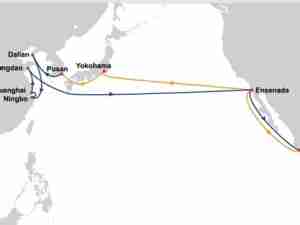- Different methodologies produce different figures for global fleet size. A.P. Moller-Maersk A/S reckons capacity is still growing and increased by about percent in the December quarter, but that was still short of the 4 percent increase in demand representing a significant tightening of the market for the first time in at least quarters.
Container Shipping Is Finally Starting a Long, Slow Turn
By: David Fickling | Feb 09 2017 at 12:14 AM | Liner Shipping
Turning round a big ship is such a difficult task that it’s long been a metaphor for reversing processes driven by their own near-unstoppable momentum.
It’s a decent way of describing the problems of the container-shipping industry in recent years. Warnings about overcapacity date back almost a decade, yet even with a slowdown in trade, the global box fleet just kept growing and growing and growing.
The deadweight tonnage of the world’s container ships more than doubled in the decade through June 2016 and didn’t decline in any single quarter, according to IHS Global Ltd. data compiled by Bloomberg Intelligence. Even after demolitions of older and unprofitable ships began to outstrip orders of new vessels in 2012, the fleet kept expanding for four years.
Then something changed. Since June, 104 ships have left the global fleet, reducing capacity by about 2.5 million deadweight tons. That’s helped lift rates: The price for shipping a 40-foot container from Hong Kong to Los Angeles has tripled from $776 to $2,336 at the end of January, according to Drewry, the London-based research firm—the highest level for the route since 2013, and not far below the record in figures dating back to 2011.
In many ways, the world’s container lines still appear to be in heavy seas. Hanjin Shipping Co., South Korea’s biggest line until it sought bankruptcy protection last August, may start to be liquidated soon after a Seoul judge ended its receivership earlier this month, Bloomberg News reported Thursday.
A.P. Moller-Maersk A/S, owner of the world’s biggest container line, this week surprised the market by posting its second annual loss since World War II and warned of the “very negative effect” of any trade war between China and the U.S.
Forecast Maersk Line 2017 profit: $600M+
There’s good news buried in both events, though. A fire sale of Hanjin’s assets is the best possible of the likely outcomes for a shipping industry awash in excess capacity (having scrap dealers buy the entire fleet would be better still). And Maersk forecast net income at its container line would be about $1 billion higher than the $384 million loss this year, thanks in part to container demand that’s growing faster than capacity for the first time in at least 15 quarters.
Container lines face a few remaining squalls. While prices on routes from China to the U.S. and Europe have rebounded, the traditional discount for boxes going in the other direction is as deep as ever, so most lines continue to make losses. And that trade war could still happen, though U.S. container port volumes grew at a healthy 8.7 percent annual clip in December.
Still, with capacity easing and a reported three-way takeover battle for Hong Kong’s Orient Overseas Container Line Co. marking a likely endpoint to the wave of consolidation in the last 12 months, the industry’s worst years are finally slipping into its wake.
This column does not necessarily reflect the opinion of Bloomberg LP and its owners.





